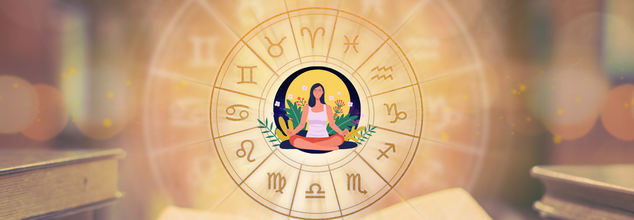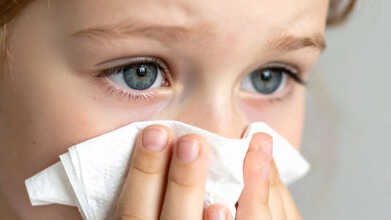- Health Conditions A-Z
- Health & Wellness
- Nutrition
- Fitness
- Health News
- Ayurveda
- Videos
- Medicine A-Z
- Parenting
Weekly Health Horoscope For December 22-28, 2024: Change Your Diet To Restore Your Vitality

Aries
Time to give it some rest! Changing your daily activities will help you to lower the tension you feel this month. Ignoring health issues after the half of this month will cause the severity of heart or stomach related ailments to rise. Attending Power Yoga sessions can help you keep yourself concentrated and preserve your strength. Those who have been dealing with frequent illnesses will recover quickly beginning later this month.
Taurus
Exerting oneself too much can aggravate blood-related issues including respiratory problems. Stress levels will sharply increase following the first half of the month, which will cause an unexpected drop in the energy availability. Retreats stressing yoga or meditation could offer a reprieve to people suffering with ongoing medical problems.
Gemini
Your health will continue to deteriorate during this month as you did not get adequate rest. Should your degree of concern rise, you could find trouble sleeping, have problems with your eyesight, or get more headaches. Illnesses linked with blood or seasonal flues will cause problems around the end of the month. If you assemble a plate of foods high in fiber and protein, you will be better able to sustain your energy levels.
Cancer
If you are clear about the objectives you wish to reach this month, you will enable your wellness to be back on track. People would be under too much stress, which could lead to high blood pressure or heart problems. Eating food at odd times will aggravate gastrointestinal issues even more. Attaching a yoga session or a power walk will help you release any tension you have been storing in and assist in muscular relaxation.
Leo
For Leos, health and wellbeing center on striking a balance between relaxation and exercise. Spontaneous pleasures will aggravate gastrointestinal problems or bring back seasonal flues. Those with any heart or blood-related problems should especially exercise great caution after the middle of the month. The slow walk-in character of this month will assist you to keep your energy and raise your mood.
Virgo
Your health demands attention during this time because of certain issues including muscle weakness and neck spasms. Poor posture, stress, or underlying diseases could all contribute to these problems; hence, proactive management of these is rather crucial. Early management of these issues helps to avoid more complications. Correct ergonomics, consistent stretching, and maybe physical treatment will help control neck spasms and increase muscle strength. Your dietary patterns may cause nutritional deficits, therefore weakening your immune system and increasing your susceptibility to diseases.
Libra
You will be able to recuperate quickly if you have chronic diseases. One should be excited about this. Conversely, too strong or low blood pressure as well as respiratory problems could result from excessive discharge. Starting a consistent workout program around the end of the month will help the muscles avoid aggravation of their aches and pains.
Scorpio
Keep in regular contact with oneself. You will come to see this month that you have to start looking after your health better. Eat and drink carefully; issues with the stomach will worsen with your choices. Those suffering with knee, back, or chest issues will feel better. After stress, breathing or blood issues will resurfaced close to the end of the month.
Sagittarius
Spend this week slowly recovering and start forming fresh self-care routines right away. Those who have piles or blood-related weakness should exercise great care. This month, you should give morning yoga top importance to avoid knee or back issues.
Capricorn
Engage the brakes! You will look for yourself this month by keeping your surroundings as cosy and soothing as feasible. Eating outside of your prescribed diet will aggravate an old condition like heartburn. You will have to give your husband's or your children's health more particular attention. Be cautious around the end of the month since rushing could cause little collisions.
Aquarius
pause and let things clear out! This is the perfect month for you to tend to and grow personally. Load on lean proteins and vegetables to keep in season. Keep stomach or flu issues under close supervision. Having looked after your ailing mother, you are probably both physically and mentally exhausted. Changing your diet will work wonders to restore your vitality.
Pisces
Majority of the time should be spent on yourself! December is a great month to change your habits such that they help you to keep your health. Ignoring to follow a healthy lifestyle will aggravate your already existing heart and gastrointestinal problems significantly. Those who suffer with recurrent ailments will find their symptoms better.
Adenovirus: Is The Mystery Illness That’s Spreading Highly Contagious?

Credits: Canva
A little-known virus is spreading steadily across different parts of the world, prompting growing concern among health experts. Often described as “untreatable” because there is no targeted antiviral medicine available, adenovirus is drawing attention due to how tough it is and how quickly it can pass from person to person.
Eric Sachinwalla, medical director of infection prevention and control at Jefferson Health, has cautioned that while most healthy individuals develop only mild illness, people in high-risk groups may face more serious health problems. This raises an important question: just how contagious is this mystery illness that is spreading?
Adenovirus: How Contagious Is It?
Yes, adenovirus is highly contagious and spreads with ease in several ways. It can pass through respiratory droplets released during coughing or sneezing, close physical contact such as hugging or shaking hands, and contact with contaminated surfaces like toys and towels.
It can also spread through fecal matter, particularly during diaper changes, and in some cases through water. According to the CDC, the virus spreads quickly in crowded settings such as schools and daycare centres and can survive for long periods on surfaces, making good hygiene especially important for young children and people with weakened immune systems.
Who Do Adenoviruses Affect Most?
Adenoviruses can infect people of all age groups, but they are most commonly seen in children under the age of five. In babies and young children, the virus often spreads in daycare environments where close contact is common. Children are also more likely to put shared objects in their mouths and may not wash their hands as regularly.
Among adults, adenoviruses tend to spread in crowded living conditions. People staying in dormitories or military housing may have a higher risk of infection. The virus is also known to circulate in hospitals and nursing homes, as per CDC.
Those with weakened immune systems are more likely to become seriously ill from an adenovirus infection. This includes people who have undergone organ or stem cell transplants, as well as those living with cancer or HIV/AIDS. Individuals with existing heart or lung conditions may also face a higher risk of severe illness.
Adenovirus: What Are The Symptoms Of An Adenovirus Infection?
The symptoms of an adenovirus infection depend on the part of the body affected. Most commonly, the virus targets the respiratory system. When it infects the airways, it can cause symptoms similar to a cold or the flu. These may include:
- Cough.
- Fever.
- Runny nose.
- Sore throat (pharyngitis).
- Pink eye (conjunctivitis).
- Ear infection (otitis media).
- Swollen lymph nodes.
- Chest cold (bronchitis).
- Pneumonia.
Adenoviruses can also infect the digestive system. When this happens, diarrhea may occur, along with gastroenteritis. Gastroenteritis is inflammation of the stomach or intestines and can lead to stomach pain, diarrhea, nausea, and vomiting.
In rarer cases, adenoviruses can affect the bladder or the nervous system. Infection of the bladder may result in urinary tract infections. When the nervous system is involved, it can lead to serious conditions affecting the brain, including encephalitis and meningitis.
Flu Incubation Period: How Long Does It Take For Symptoms To Appear?

Credits: Canva
Influenza, commonly called the flu, is a respiratory infection caused by the influenza virus. It is contagious, which means it passes easily from one person to another. Although influenza viruses can circulate throughout the year, infections are seen more often during the fall and winter months. This time is known as the flu season. As flu cases are rising across many parts of the US and UK, here are a few key points to understand, from the incubation period to how easily the virus spreads.
What Is The Flu (influenza)?
The flu is an infection caused by the influenza virus. It usually leads to symptoms such as body and head aches, sore throat, fever, and breathing-related discomfort, which can sometimes become serious. Flu cases tend to peak during the winter months, when large numbers of people may fall ill at the same time, a situation described as an epidemic, according to the Cleveland Clinic.
Flu: What Is The Incubation Period Of The Flu?
The average incubation period of the flu is around 2 days, though it can vary from 1 to 4 days. In simple terms, this means most people begin to notice flu symptoms a few days after the virus enters the body.
When Does The Flu Become Contagious?
After catching the flu virus, a person can start passing it on to others about 1 dayTrusted Source before symptoms appear. Keep in mind that the usual incubation period is about 2 days. So, if someone is exposed to the virus on a Saturday morning, they may already be able to spread it by Sunday evening. By Monday afternoon, flu symptoms are likely to show up. These symptoms can be mild or severe.
Some people may not develop symptoms at all, but they can still spread the virus. The flu is usually most contagious during the first 3 days of illness. After symptoms begin, a person may continue to infect others for another 5 to 7 days. Children, older adults, and people with weaker immune systems may remain contagious for a longer time.
Flu Symptoms 2025: Early Symptoms You Need To Take Care Of
Unlike the common cold, which tends to develop slowly, flu symptoms often appear suddenly.
Common symptoms include:
- feeling extremely tired, exhausted, or weak
- headache
- blocked or runny nose
- sore throat
- dry cough
- muscle and body aches
- fever or chills, although not everyone gets these
- vomiting or diarrhoea, which is seen more often in children
Most people start to feel better within a few days to two weeks. However, some individuals may need antiviral medication, particularly those at higher risk of serious complications.
How Does The Flu Spread?
The flu mainly spreads through tiny respiratory droplets released when an infected person coughs or sneezes. In crowded places, these particles can be inhaled by others, leading to infection. The virus can also spread by touching objects or surfaces that carry the virus, such as door handles or shared personal items. Outside the body, the virus can survive on surfaces for up to one day.
If someone touches a contaminated surface and then touches their eyes, nose, or mouth, the flu virus can enter the body and cause infection.
Taking Warfarin? Doctor Warns This Common Food Could Be Reducing Your Medication’s Effect

Credits: Canva
People who are prescribed blood thinners, also known as anticoagulants, could unknowingly weaken the effect of their medication by eating a widely consumed and otherwise healthy vegetable, a doctor has warned.
What Are Anticoagulants?
Anticoagulants are routinely given to reduce the risk of blood clots and are often prescribed to those who face a higher chance of such complications. This group also includes people at increased risk of heart attacks or strokes. These medicines, which include rivaroxaban, apixaban and warfarin, work by interrupting the clotting process and play a key role in preventing serious conditions such as strokes, heart attacks, pulmonary embolism and deep vein thrombosis.
Warfarin: Why This Common Vegetable Can Be A Problem
While anticoagulants are effective and often lifesaving, patients are being advised that a familiar garden vegetable could interfere with how well these drugs work. The warning comes from Dr Chris Steele, who appeared on ITV’s This Morning to explain how certain foods can interact negatively with different medications.
As part of his advice, he said, as per Express, “Leafy greens are high in vitamin K, which helps blood to clot. Warfarin works by blocking vitamin K production, so if you suddenly increase how many greens you eat, it can affect how the medicine works.”
He added: “Other foods that contain a lot of vitamin K include green vegetables, egg yolks, chickpeas and lentils. These foods don’t need to be removed from the diet, but it is important to keep your intake steady and consistent. You should also avoid drinking large amounts of cranberry juice or using cranberry products while on anticoagulants, as they can alter the effect of warfarin. Garlic and ginger should be limited too, as they can raise the risk of bleeding.”
Warfarin: Other Food And Drug Interactions To Watch For
Dr Chris also highlighted that many other medicines can react in unexpected ways when taken alongside certain foods and drinks. For example, he noted that some antibiotics, including ciprofloxacin, can react poorly with milk.
He explained: “Calcium can reduce how well some antibiotics work, so these medicines should not be taken at the same time as foods high in calcium, such as milk, yoghurt or cheese. Calcium supplements should also be avoided for a few hours before and after taking these antibiotics.
“You should not drink milk when taking certain antibiotics, including tetracycline and ciprofloxacin, which are quinolone antibiotics, or some osteoporosis drugs like alendronate, also known as Fosamax.”
He further advised avoiding the following combinations with specific medicines:
- Grapefruit if you are taking statins for high blood pressure
- Black liquorice if you are on certain heart medicines such as digoxin
- Bananas if you take some ACE inhibitors for high blood pressure
- Coffee if you use bronchodilators for asthma
- Smoked salmon and salami if you are prescribed antidepressants
- Limes if you are taking cough medicine
Dr Chris stressed: “Always speak to your doctor about any precautions you should follow when starting a new medication. You may need to avoid certain foods, make changes to your lifestyle, or take other steps to prevent unwanted side effects.”
© 2024 Bennett, Coleman & Company Limited

